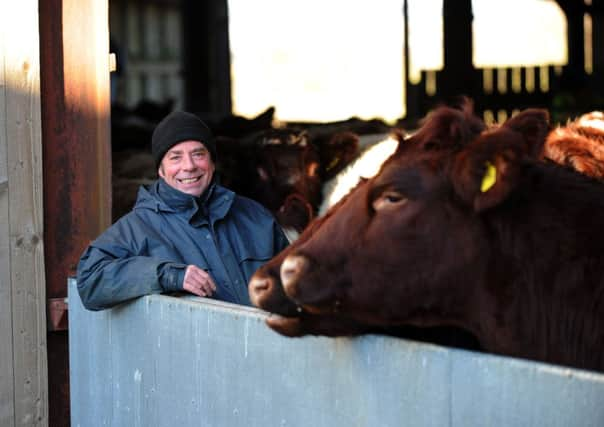From grim dereliction to a farm for all to enjoy


Ian Smart is charged with reviving the farm at Berry Brow on the urban fringe of Huddersfield and inspiring locals to take an active part in its future success, as well as educating new generations about farming and wildlife.
In the farm’s first four years he has brought livestock back to the farm, started work on grassland and habitat restoration and grown vegetables, fruit, wildflower and hay meadows. He admits there’s a long way to go but he’s proud of what’s been achieved so far.
Advertisement
Hide AdAdvertisement
Hide Ad“We came to a bunch of derelict buildings and at first couldn’t see how we were going to bring them back into use, but we’ve managed to develop the stone barn into an education centre and adapted other farm buildings to house machinery and livestock. We’re also now ever so close to getting part of the farmhouse converted into office space.
“Ultimately the farm has to be self-sustaining. Stirley Community Farm’s business model is set out to be low input and is based around beef production and selling beef boxes through a community-supported agricultural scheme.
“Our farm model is slightly different to most. We engage people through events and volunteering opportunities here at the farm and sign them up to the wider work we undertake. In order to make everything affordable we give people the opportunity to pay by a monthly direct debit and as part of their involvement they receive a 10kg box of beef from our herd.
“Usually with community farms working under that model the business risk is shared between the farm and with those who have signed up on the scheme, but at the moment we take all of the risk.”
Advertisement
Hide AdAdvertisement
Hide AdIan’s pride and joy is his fledgling pedigree Beef Shorthorn herd. He purchased a dozen cows in autumn 2011 and he’s now up to 20 sucklers and has his own bull.
“I’d worked with Beef Shorthorns before and when I came here we knew that we wanted a breed that would suit a low input system and finish readily on grass. Another important consideration was that as we are a community farm we get a lot of people helping us with bedding down, feeding, calving and simply checking the animals and many of them may not have been near cattle previously so will have little experience. That’s why I particularly wanted a breed that is well-known for its good temperament.
“We’re growing the herd and I can see our stocking density being around 40-50 sucklers with followers in the years to come. One area that we need to address quickly is the cattle buildings. We’ve adapted what were dairy cow sheds with cattle stalls and a roof that’s just 8ft high. That doesn’t work too well but we have a new cattle building planned for this year that will suit the herd.”
The success of the beef box scheme and gives Ian confidence for the farm’s immediate future.
Advertisement
Hide AdAdvertisement
Hide Ad“We sent out just under 100 boxes with a range of cuts in each. Our projections are that we are 18 months to two years away from balancing the books.
“In the longer term it would be good to see mixed stocking on the farm with a sheep flock as well as the beef herd but the lack of infrastructure is the main hindrance. The lack of fencing and mains water across the whole of the farm is our main limiting factor, as well as finding the money to pay for it.”
Farming on the urban fringe has its own problems. As the land was without a tenant for a decade with little boundary fencing, it was seen as fair game for roaming. Ian wants the public to enjoy the land, but without abusing it and being aware of the livestock and what’s being attempted on the farm.
“We want people to come here and have open access because in doing so we will have more opportunity to engage them and educate them about farming, wildlife and the wider landscape. We get a high number of dog walkers and while we don’t have problems with neospora (abortion in cattle from contact with dog faeces) dog walking in certain areas may become a problem as the herd grows.
Advertisement
Hide AdAdvertisement
Hide Ad“One of our most frustrating concerns has been where we have managed to put up some fencing there are holes then cut almost immediately. It’s happened several times. I can only assume it’s someone who has had a set route across the land but it’s frustrating as they’re less than ten metres from a footpath and a stile.
“We also have quad bikes and dirt bikes that shouldn’t be here but without a full network of fencing it’s difficult to control.”
However, Ian is more concerned with the positives that have come since his move from Dorset where he was West Dorset reserves manager for Dorset Wildlife Trust.
“We’ve taken on what was a quite intensive dairy farm and have already come up with a site that has beef cattle; an acre of vegetables and fruit with everything from potatoes to carrots, kale, cabbages, beetroot and strawberries, raspberries, gooseberries, apples, pears, plums and damsons. We’re developing our hay fields and wildflower meadows and we’re self sufficient in haylage.
Advertisement
Hide AdAdvertisement
Hide Ad“The children that come here on school trips are loving it and the other two people who work with me – Kim Warren (community engagement) and Annie Russell (education) - are really moving us forward.
“The children take part in sessions with the livestock and learn about their part in managing the landscape; and also picking vegetables that they bring back into the education centre where there can process them and even cook them.”